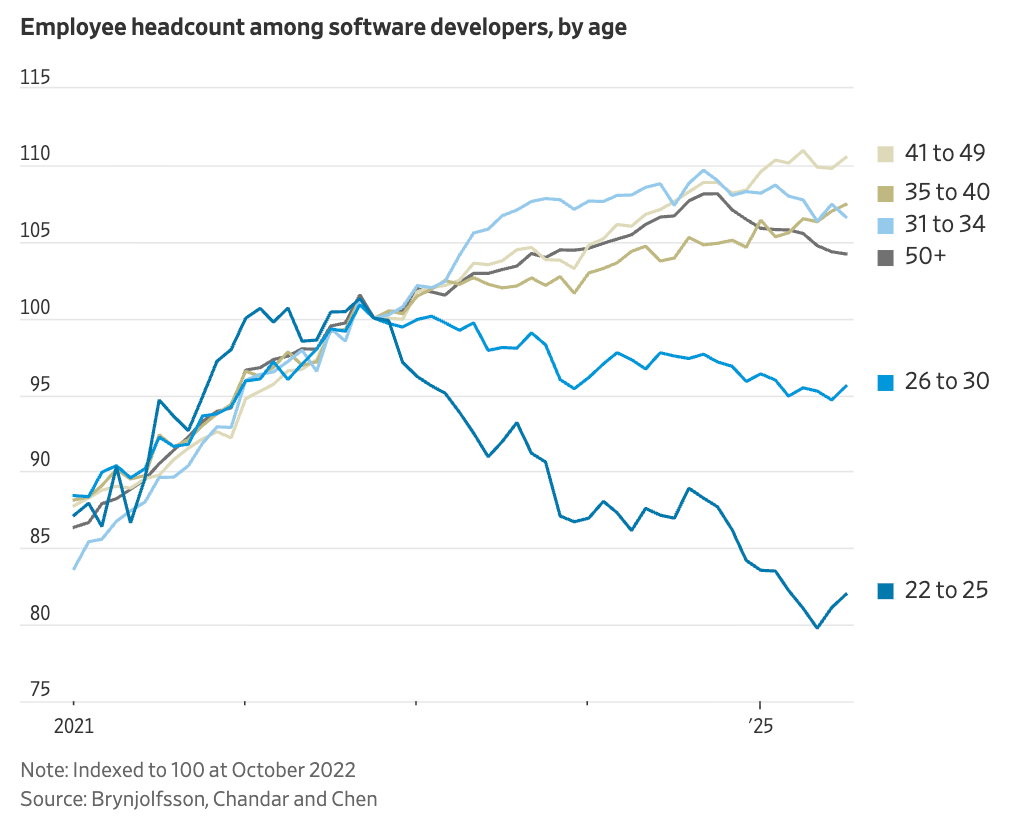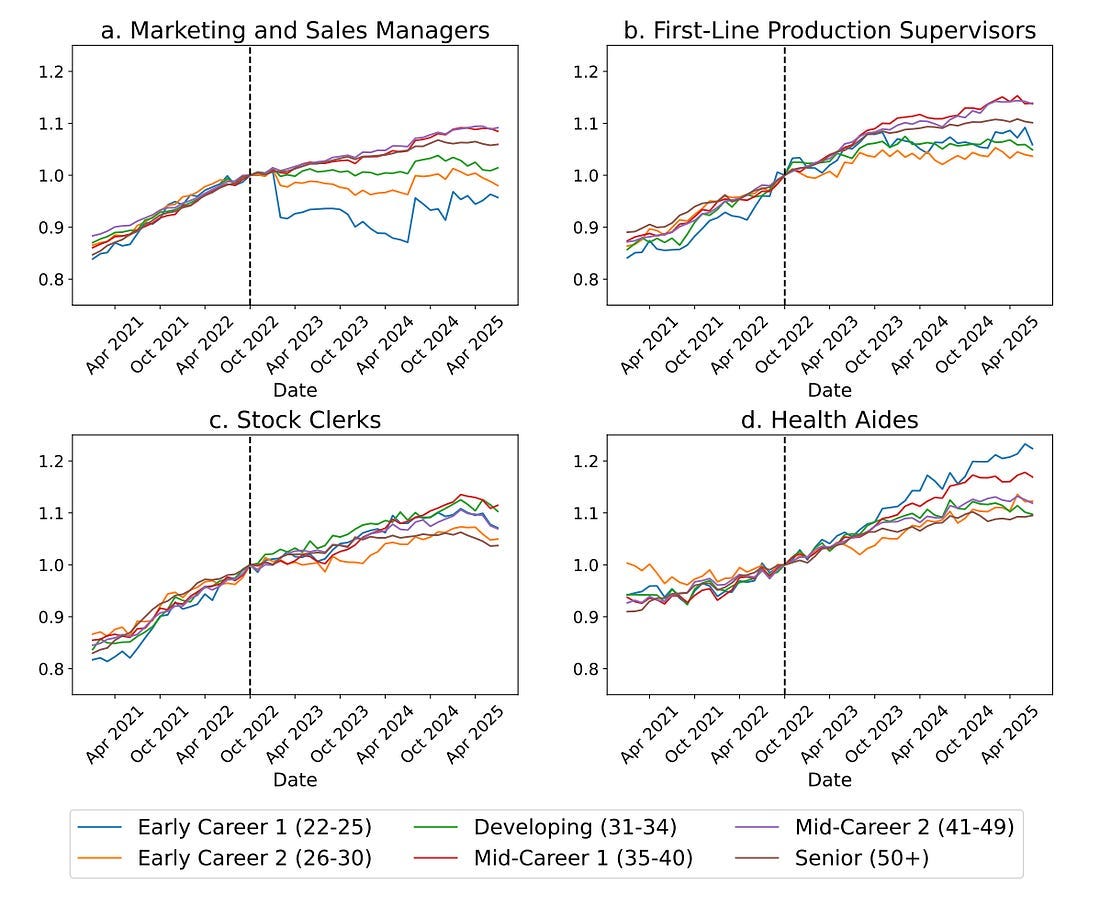How to Productize AI Anxiety
Navigating Around Anxiety and FOMO in Applied AI
Weekly writing about how technology and people intersect. By day, I’m building Daybreak to partner with early-stage founders. By night, I’m writing Digital Native about market trends and startup opportunities.
If you haven’t subscribed, join 70,000+ weekly readers by subscribing here:
How to Productize AI Anxiety
It’s not surprising that there’s a lot of AI anxiety right now; we have a long history of doomsday sci-fi portrayals of AI.
Way back in 1920, a Czech play called “R.U.R. (Rossum’s Universal Robots” introduced the word “robot” to society. The storyline? Artificial workers gain consciousness and revolt. Here’s an image from the play:
I spent much of Labor Day weekend watching Battlestar Galactica, the 2003 cult classic TV series. (I’d never seen it—I know, I know.) The premise of the show: humans create Cylons, sentient robots designed to help our species. Naturally, the Cylons rebel and become set on exterminating humans. The show covers a brutal war that ensues between human and Cylon.
The list goes on: Terminator (self-aware AI launches nuclear war and creates killing machines), 2001: A Space Odyssey (“I’m sorry Dave, I’m afraid I can’t do that” - Hal 9000), The Matrix (AI enslaves humanity), even the more recent M3GAN (murderous AI doll!). It’s no wonder people freak out when Sam Altman says AGI is imminent.
One of my favorite recent cartoons:
There’s a lot of anxiety when it comes to AI, period. But there’s especially a lot of anxiety when it comes to AI + work.
Last week, a Stanford survey about AI and jobs made the rounds. Here’s Derek Thompson summarizing the findings:
In a new paper, several Stanford economists studied payroll data from the private company ADP, which covers millions of workers, through mid-2025. They found that young workers aged 22–25 in “highly AI-exposed” jobs, such as software developers and customer service agents, experienced a 13 percent decline in employment since the advent of ChatGPT. Notably, the economists found that older workers and less-exposed jobs, such as home health aides, saw steady or rising employment. “There’s a clear, evident change when you specifically look at young workers who are highly exposed to AI,” Stanford economist Erik Brynjolfsson, who wrote the paper with Bharat Chandar and Ruyu Chen, told the Wall Street Journal.
Here are a couple charts covering the two professions the paper singled out—software developers and customer service agents:
Yikes. Young workers are clearly hurting the most here. This dovetails with what I hear anecdotally from companies: AI isn’t causing employers to fire workers (yet); rather, companies are simply reducing their hiring plans. If you were going to hire 30 engineers next year, maybe you can now make do with five. If you were going to hire 20 customer service reps, maybe three will do. And so on. Companies can do more with less. Existing workers, naturally, tend to skew older, which is why those cohorts look okay in the charts above. Meanwhile, new entrants to the job market (the young workers) are getting shafted.
By the way, the Stanford report does a good job showing that this isn’t an economy-wide trend. For instance, you can see here how home health aides are unaffected, while “AI-exposed” jobs like marketing and sales managers are deeply impacted:
Sure, people might fret about Battlestar Galactica-level wars with robots down the road. But right now, most people are just worried about AI taking their job.
For applied AI companies, this means you have to navigate customers who are weary and wary of your product. This isn’t easy. I’ve been calling this “productizing AI anxiety.” How do you leverage AI anxiety and FOMO to your advantage?
Let’s touch on two sides of the equation: (1) marketing / sales and (2) product.
Marketing / Sales
On the marketing side, applied AI companies need to make their product synonymous with:
We will save you time.
We will save you money.
We will keep you on the bleeding edge.
Overall, I summarize this as: “We’ve got you covered.” Hit customers over the head with it. Your product = peace of mind. “Work with us,” you should say, “and you’ll never worry that you’re falling behind.”
For an executive who is fretting about AI, who feels like their company is falling behind, how do you communicate “We’ve got you covered?” An example of a company that’s done this well is Harvey. Harvey quickly became synonymous with legal AI. This was largely on the strength of savvy brand messaging and marketing. Harvey had great timing, sure, but they were everywhere. Any lawyer worth their salt was saying, “Hey—this AI thing is moving pretty fast. I heard about this company called Harvey. Should we be using it?”
Harvey used this tactic to gobble up market share. The critique on Harvey has always been that engagement is low; “I don’t know any lawyers who actually use it” and so on. But Harvey got its foot in the door to most major law firms, and engagement is now improving. When the company announced $100M in ARR last month, they noted that growth is largely driven by expansion: weekly average users have quadrupled over the past year. Harvey manifested its own success.
Marketing, sales, and brand should all funnel into the same goal: communicating to customers “We’ve got you covered.” You want industry professionals asking their colleagues, “Hey, I keep hearing about ___. Should be using it?” Your company should = peace of mind.
Product
Obviously, good marketing and brand only get you so far; the product needs to be there too.
On the product side, the biggest mistake I see companies make is throwing every bell and whistle into the product, then alienating the customer. People don’t really care about fancy features, and they definitely don’t care which model you’re using. They care about the core jobs to be done and whether those jobs can be accomplished in a simple, intuitive interface.
Also—there’s such a thing as too much, too fast. If you’re a startup pitching a group of employees, and you’re bragging that you can replace half of them, you’re shooting yourself in the foot. Savvy applied AI companies start by pitching the core feature or two that workers really care about: what’s going to save the most time and headaches? (Note: this might be different if you sell into execs or into lower-level ICs.) Then, once the foot is in the door, you can gradually layer on more features to tackle more complex tasks and expensive workflows.
The key to nailing product in applied AI is to balance engineering / product / design expertise with domain expertise. To take another example in the legal AI world: Crosby, which is reinventing contract law, nails this balance. Crosby’s Ryan Daniels recently tweeted that Crosby staggers desks between engineers and subject matter experts: they require every lawyer to sit between two engineers, and vice versa.
This forced marriage between domain expertise and tech expertise ensures a product that is actually built for the customer, not just for Silicon Valley. You can see that DNA in Crosby’s founding DNA too: Ryan went to Stanford Law School and worked at Cooley (he has good startup experience to boot); Ryan’s co-founder John was an engineer at Ramp. Subject matter 🤝 tech.
It’s easy to get carried away on the tech and alienate who you’re building for. Good applied AI doesn’t sacrifice customer centricity.
Final Thoughts
I’ve been thinking a lot about these topics—how companies can navigate around inevitable AI skepticism and actually lean into FOMO and anxiety. This will only become more important, as the pace of AI accelerates and more dislocation happens within workforces.
There was a lot of hand-wringing that came out of a recent MIT report that showed 95% of enterprise gen AI pilots fail due to poor integration and workflow fit. But I don’t think that study means that AI is overhyped. Rather, it means that startups aren’t doing a great job helping big organizations adjust to rapid change. Technology moves a lot faster than a law firm, a construction business, or an investment bank. The key is to toe the line between tech change and organization change—to understand the natural anxieties and FOMOs and to not ignore them, but lean into them in smart and savvy ways.
Thanks for reading! Subscribe here to receive Digital Native in your inbox each week:







